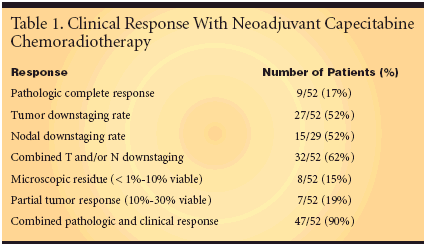Oral Capecitabine May Simplify Chemoradiotherapy for Rectal Cancer
HOUSTON-Concomitantboost radiotherapy plus capecitabine(Xeloda) produces pathologic responserates comparable to those of
HOUSTON-Concomitantboost radiotherapy plus capecitabine(Xeloda) produces pathologic responserates comparable to those ofcontinuous infusion fluorouracil (5-FU) for patients with locally advancedcolorectal cancer (abstract 3593). Resultsfrom a phase II study also showthat capecitabine is well tolerated andavoids the discomfort and potentialcomplications associated with continuousinfusion 5-FU, like infection andphlebitis.Edward H. Lin, MD, and colleaguesat the University of Texas M. D. AndersonCancer Center in Houston, enrolled54 patients in the study. Allpatients had rectal carcinoma > T3 orN1(+) and normal renal, hepatic, andhematologic function. The Eastern CooperativeOncology Group performancestatus ranged between 0 and 2.The median age was 58 years (range36-76 years).As part of the rationale for the study,the investigators noted that using 5-FU as a radiation sensitizer for rectalcancer produces pathologic completeremissions of 8% to 30% and thatcapecitabine, an oral fluoropyrimidine,is converted to 5-FU in tumortissue, enabling chronic dosing thatmimics continuous infusion 5-FU."Oral capecitabine simplifies chemoradiation,"the investigators concluded,"avoiding the unwanted risks andinconvenience associated with IV 5-FU."Combined Response of 90%Oral capecitabine (825 mg/m2twice daily) was administered for 35continuous days during radiation therapywith concomitant radiation boostsof 45 Gy x 25 to the pelvis and 52.5 Gyx 30 fractions to the primary tumorand perirectal nodes. Following surgery,eligible patients received fourcycles of capecitabine (1,250 mg/m2twice daily) for 14 days every 3 weeks.

Pathological complete response, theprimary endpoint of the study, wasreached in 9 of 52 patients (17%). "Itis interesting to note that the responsein patients with microscopic residualdisease (15%) was almost as high asthe pCR rate," the investigators noted.Sphincter preservation was achievedin 17 of 29 patients (59%) with tumorsthat were ≤ 6 cm from the anal verge.Only one patient had progressive disease.The combined clinical and pathologicalresponse rate was 90% (seeTable 1)."Results from the current study appearsimilar to historical data fromtrials using the conventional radiotherapytechnique," the investigatorsconcluded.Mostly Mild to ModerateAdverse EventsMost treatment-related adverseevents during preoperative chemoradiotherapywere grade 1. Commongrade 1/2 clinical toxicities includeddiarrhea, radiation dermatitis, fatigue,and hand-foot syndrome. Radiationdermatitis, hand-foot syndrome, anddiarrhea also occurred as grade 3 clinicaltoxicities. The only grade 4 adverseevent was diarrhea, which wasreported in 2% of patients and led toearly patient withdrawal. No treatment-related deaths occurred.Lymphopenia, uncomplicated byinfection, was the most common hematologictoxicity, with grade 2 lymphopeniaoccurring in 27% of patientsand grade 3 lymphopenia, in 52% ofpatients. Neutropenia and anemiawere rare. There were no grade 4 toxicities.As permitted by protocol, 31%of patients received adjuvant FOLFOX(5-FU, leucovorin, oxaliplatin [Eloxatin])therapy, at the clinician's discretion.
Newsletter
Stay up to date on recent advances in the multidisciplinary approach to cancer.